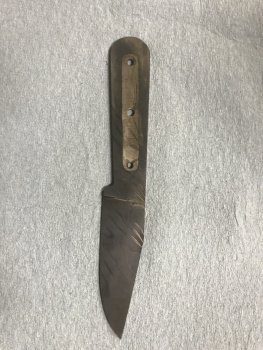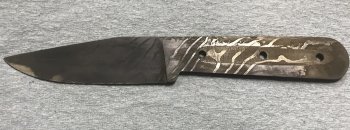tkroenlein
Well-Known Member
I *attempted* etching my first damascus blade. It looks...wrong.
The particulars:
11 layer 80CrV2 and 15N20. Slow twist. Hand hammered. Welded perfectly, no flux. Rough ground to 220 ish, coated in Turco, normalize, thermal cycled, quench in 10 sec commercial oil. Hand sanded to a an honest 400 grit.
Etched in fresh 3:1 ferric chloride. Washed and rinsed in hot water, degreased with isopropyl.
Etched attempted 2 times. Same result each time.
80CrV2 layers have a couple of shiny spots. 15N20 turns as black or blacker than 80CrV2. Oxides don't scrub off with steel wool. 15N20 layers are obviously more resistant to etch because they are higher than 80CrV2 after 15 minutes. Any advice appreciated.
The particulars:
11 layer 80CrV2 and 15N20. Slow twist. Hand hammered. Welded perfectly, no flux. Rough ground to 220 ish, coated in Turco, normalize, thermal cycled, quench in 10 sec commercial oil. Hand sanded to a an honest 400 grit.
Etched in fresh 3:1 ferric chloride. Washed and rinsed in hot water, degreased with isopropyl.
Etched attempted 2 times. Same result each time.
80CrV2 layers have a couple of shiny spots. 15N20 turns as black or blacker than 80CrV2. Oxides don't scrub off with steel wool. 15N20 layers are obviously more resistant to etch because they are higher than 80CrV2 after 15 minutes. Any advice appreciated.



